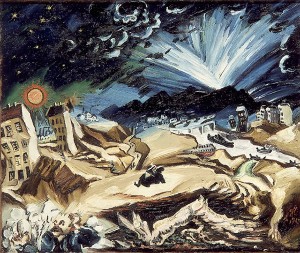A cold wind blows tiles off of roofs and hats off of heads. The first pages of Robert Schindel’s new novel Der Kalte (The Cold One), read here by the author, are stormy. The Austrian novelist, poet and essayist born in 1944 already won over his readers with his persuasive images and poetic language in Gebürtig (Born-Where), published in 1992. Here too, the atmospheric beginning is reminiscent of the first line of the expressionist poem “Weltende” (End of the World): “From bourgeois’ pointed heads their bowlers flew, the whole atmosphere’s like full of cry” (Jakob van Hoddis).

Apocalyptic Landscape by Ludwig Meidner, 1913
© Ludwig Meidner-Archive, Jewish Museum Frankfurt-am-Main
Yet in the first scene of Schindel’s novel a world unfolds: Vienna of the Waldheim affair, from 1985 to 1989. During the 1986 Austrian election campaign, a debate ignited around the conservative candidate, Kurt Waldheim, who was indicted for war crimes. In his autobiography, he had concealed his time as a Wehrmacht-officer. Represented in the novel by the figure Johann Wais, he professes “that he had done nothing that one hundred thousand other Austrians had not done, too.” This is precisely why he functions “as an involuntary clarifying machine.” → continue reading